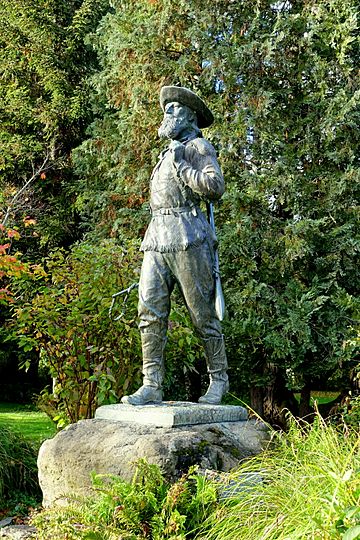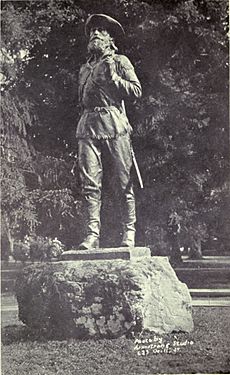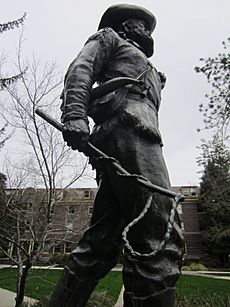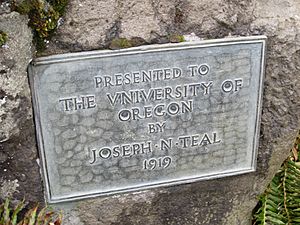The Pioneer (Eugene, Oregon) facts for kids
Quick facts for kids The Pioneer |
|
|---|---|

The statue in 2017
|
|
| Artist | Alexander Phimister Proctor |
| Year | 1919 |
| Type | Sculpture |
| Medium | Bronze |
| Subject | An Oregonian pioneer |
| Dimensions | 4.0 m (13 ft) |
| Location | Eugene, Oregon, United States |
| 44°02′45″N 123°04′33″W / 44.04578°N 123.07579°W | |
The Pioneer is a large, 13-foot-tall bronze sculpture. You can find it on the University of Oregon campus in Eugene, Oregon, United States. A famous artist named Alexander Phimister Proctor created it. A lawyer named Joseph Nathan Teal asked him to make it.
The statue was officially shown to the public on May 22, 1919. Many people came to the special event. This included students and some of the original pioneers. A pioneer named T. G. Hendricks and his granddaughter helped unveil the statue.
Contents
Creating the Pioneer Statue
Creating The Pioneer took a long time. Artist Alexander Phimister Proctor had already made other pioneer sculptures. But he wanted to create one that truly showed the "spirit of the West."
After searching for ten years, he found the perfect person to model for the statue. This person was J. C. Cravens, an "old trapper." He had a long beard, thick boots, a buckskin coat, and carried a rifle. He even led a horse.
Once Proctor had his model, he shared his idea with Joseph Teal. Mr. Teal was a lawyer and businessman in Portland. He then asked Proctor to create the sculpture. This was the very first statue placed on the University of Oregon campus.
What the Pioneer Statue Looks Like
The Pioneer statue shows a strong and moving figure. The sculpture looks like the model Proctor found. The figure wears similar clothes, has a full beard, and carries a rifle over his shoulder.
His body shows pride, with his shoulders back and his chin held high. He looks like he is about to move forward. His eyes gaze ahead, and his weight seems to be shifting. The statue stands on a natural, rough rock base.
The artist chose a basalt rock that had "weathered many storms." He felt this rock matched the idea of a pioneer. Pioneers also faced many challenges and kept going. The statue shows inner strength, ready to face what comes next.
Where the Pioneer Statue Was Placed
The location for the statue was chosen very carefully. The bronze statue was made in Rhode Island. It traveled for over a month by train to reach Oregon.
Artist Proctor explained why this spot was perfect. He said that the Willamette and McKenzie rivers meet here. They form a beautiful valley. This valley was like a "paradise" for pioneers. They traveled over mountains and deserts to make their homes here.
Proctor believed the University of Oregon campus was the best place for this memorial. A group including Mr. and Mrs. Teal helped choose the exact spot. The statue was placed among Oregon fir trees. It faced the Administrative Building, between the library (Fenton Hall) and Friendly Hall.
Even though it represents the western spirit, The Pioneer faced south. The artist planned this on purpose. Facing south allowed the statue's front to get the most sunlight.
The Statue's Name
When this sculpture was first made, its official name was The Pioneer. It was not called The Pioneer Father. The name "Pioneer Father" started to be used later. This happened after plans for a separate statue, Pioneer Mother, became public in the late 1920s.
The new name helped tell the two statues apart. However, this change made people forget the original meaning. When The Pioneer was first shown, Joseph Teal said:
"This statue is built to remember all Oregon pioneers. It is not about one person. I truly hope everyone remembers this." "The pioneer shows the best parts of our history. The men and women who helped settle the West were driven by good reasons. They made many sacrifices and faced all kinds of difficulties. They did this so their children could have a better life."
So, the statue was meant to honor all Oregon pioneers, both men and women.
History of the Statue
In a newspaper article from 1928, the statue was described as standing "in the center of the campus." It was said to show "the pioneer spirit of the West."
By 1929, the statue was protected from damage. This happened before a big football game between the University of Oregon and Oregon State University. In 1931, a newspaper mentioned that orange paint, a color linked to Corvallis, was found on the campus. It was even on The Pioneer statue.
In 1963, a newspaper reported some Halloween fun. Someone decorated the Pioneer Father statue. They made it look like arrows were sticking out of him. A toy tomahawk was also placed on his head.
The statue was damaged in April 2019. Then, on May 20, 2019, students from the Native American Students Union held a protest. This was 100 years after the statue was put up. They asked for The Pioneer to be removed. They felt it did not represent the experiences of Native American peoples of Oregon.
The university president, Michael Schill, then formed a committee. This group was asked to suggest ways to show history on campus. They wanted to include people from many different backgrounds.
On June 13, 2020, after a gathering, some people pulled down and damaged the statue. They moved it to the steps of Johnson Hall. The Pioneer Mother statue was also pulled down and damaged. The next day, the university put both statues into storage.
Images for kids








